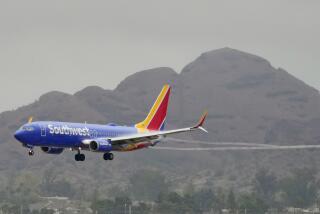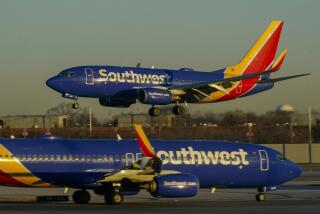Commuter Carriers Pick Up the Spoils as Major Airlines Retrench : Transportation: Their business is literally soaring as they find a niche in the abandoned shorter routes.
- Share via
His black valise in tow and a blank stare on his face, Christopher Atayan waits to board a small American Eagle turboprop that he dubs “the flying sewer pipe.”
Atayan logs 100,000 air miles a year as a New York investment banker. Too many of them, he said, are aboard cramped little puddle jumpers like the one he waits to board.
“They are small, they feel unsafe, are noisy and slow,” he groused while slumping against a check-in counter inside the air-conditioned confines of Orange County’s John Wayne Airport. Still, “you have to fly them.”
True to his word, Atayan troops out on the sun-baked Tarmac to climb aboard the 19-passenger British Aerospace turboprop for the hop to Los Angeles International Airport, where he will thankfully transfer to a wide-body jet for the ride home to the East Coast.
Few products or services can match the animosity that some travelers hold toward commuter airlines. Not only are the industry’s smaller, propeller-driven planes derided as airborne lawn mowers, passengers have to pay handsomely for the privilege of being jostled through what many consider not-so-friendly skies.
Yet commuter carriers have become the quiet victors of the recent airline wars. Complain as they may, about 53 million passengers flew aboard commuter aircraft last year--a 25% increase in two years--according to an industry group.
Commuter affiliates have stepped in to take over service on less-popular runs that are being abandoned by the major airlines. The majors are desperate to cut costs to make up for the more than $8 billion lost in ruinous fare wars in the past few years.
Little airlines have discovered they can turn a tidy profit flying their small planes on routes that the bigger carriers left behind. For instance, SkyWest picked up Delta Air Lines flights that had been dropped from Salt Lake City to Casper, Wyo.; Rapid City and Sioux Falls, S.D., and Butte, Mont.
It’s a good deal, too, for the retreating carriers. By relinquishing unprofitable routes to their commuter affiliates, they continue to be fed passengers into their profitable, long-haul routes in a bid to retain customer loyalty.
“Since 1988, the major carriers have turned over 65% of their routes of 500 miles or less to their regional partners. That’s where the growth has been,” said Walt Coleman, president of the Regional Airlines Assn., a Washington-based industry group.
Financially, the commuter carriers have many of the traits that major airlines hope to emulate as they restructure.
“Every factor of our cost structure is lower,” said Marty Hires, spokesman for American Eagle, a group of four commuter airlines affiliated with American Airlines that covers most of the country.
Regional airlines are flexible, able to add or delete routes within days based on market conditions. Their upper management isn’t slowed by large bureaucracies that have characterized some big carriers, so service problems can often be fixed with a single phone call.
Commuter carriers usually have loyal work forces that are paid less than those of major airlines, and they are not subject to rigorous union work rules that old-line carriers say make them less competitive with cost-cutting upstarts. Their smaller size results in a greater sense of teamwork.
“With SkyWest, you’re never far away from home. It’s a family,” said Jamie Berry, a Palm Springs-based flight attendant.
At the commuters, everybody pitches in, from pilots to managers, when it comes to getting planes in and out as quickly as possible--usually within 10 minutes of touchdown. “I love to work the ramp,” said Jeff Keller, Orange County station chief for Delta affiliate SkyWest Airlines.
Co-pilot Bryan Salvati personally helps passengers negotiate the steps off the plane, loads bags and still flies a schedule that would leave many of his peers looking like slackers.
“Seven stops, and that’s an easy day,” said the ex-Trans World Airlines employee as he eyed a wrinkled flight schedule he pulled from his coat pocket. “I love it. . . . The flying is better for me, and I like working with a smaller group.”
A commuter pilot with six years of experience can expect to make $32,000 to $40,000 a year, while their counterparts at a major airline earn $72,000 to $90,000, according to FAPA, an Atlanta-based career and financial planning service for airline employees. Experienced flight attendants average about $16,800 on the commuters--a third less than the average $25,200 wage for attendants on major carriers. Mechanics earn about $13 an hour, compared to $19.50 at a major carrier.
Some major airlines own their own commuter carriers outright and operate them as separate entities. American Airlines’ parent, AMR Corp. of Ft. Worth, for instance, owns all of the companies around the country that fly under the American Eagle commuter carrier.
Lower costs allow the commuter carriers to make money even if they are less than full. Even with planes of 70 seats or fewer, commuter carriers generally have break-even operations if they fill half the plane--compared to the 60% capacity needed for the major airlines, according to the Regional Airline Assn.
Part of the reason is the airplanes themselves. A 50- to 70-seat turboprop costs less than half as much to operate as a jet with twice as many seats, said Ken Roberts, manager of business operations for Allison Engine Co. in Indianapolis, which makes both jets and turboprops. Propeller planes have lower fuel costs because they are smaller, and they are generally easier to maintain.
Another reason for healthy profit margins is the generally higher fares commuter airlines can charge on many routes to otherwise isolated destinations.
“On the short legs, sometimes they will make you pay dearly, because most times there isn’t competition,” said David Stempler, executive director of the International Airline Passengers Assn. in Washington, a lobbying group.
A ticket on a flight between Orange County and Los Angeles--a 35-mile jaunt for which five commuter carriers compete--generally costs about $55 one way, although a connection onto a major carrier can severely cut the cost.
Industry representatives defend the fares as representative of the costs of flying.
“Ever since Southwest (Airlines) entered the world, we think every fare should be $69,” said Ron Reber, a SkyWest Airlines senior vice president in St. George, Utah. He added that his airlines’ fares average about $100 one way and the average trip about 400 miles.
To lure more of the traveling executives that make up their core customer base, commuter airlines have been looking for answers short of their own miniature version of a fare war. They have taken several steps to make their planes more comfortable.
Small jets are now being used on some routes, cutting travel time over longer distances. SkyWest has bought four 50-seat commuter jetliners that are being used on runs such as Salt Lake City to Burbank.
And some of the newer, bigger turboprop planes have cabins with high enough ceilings that passengers don’t have to stoop when they board. Flight attendants serve drinks and snacks.
And the commuter airline fleet is generally young--6 years old or less--with the latest in cockpit avionics.
“People look at propellers and think ‘old-time airplanes,’ ” association official Coleman said, “but they are not.”
People say they are willing to fly them for a simple reason: convenience.
“It’s only about 10 minutes’ air time, but it’s worth it,” said Al Butler, a technical engineer who drives from his Long Beach home to Orange County to fly a commuter to Los Angeles International rather than simply drive the 35 miles to the international airport. Parking costs half as much in Orange County, he explained.
Safety is an issue in many people’s minds, given how commuter airplanes are generally dwarfed on runways by the big jets. Those fears were not helped by a National Transportation Safety Board examination of the industry that was launched in March and prompted by a crash in Minnesota that killed all 18 aboard a commuter flight.
“They have a consistently higher accident rate than the major airlines,” said Ted Lopatkiewicz, a spokesman for the NTSB in Washington. The agency is discussing whether to require that planes with 30 seats or fewer be required to meet the same rigorous safety standards of larger aircraft.
Given customer preference for jets, commuter carriers are quick to withdraw service if they are challenged by low-cost jet service from a major airline on one of their routes. Witness the quick exit of United Express from its Orange County-to-Oakland routes when Southwest Airlines entered the market in May with advance purchase fares as low as $49 each way, about half of what United Express was charging for a trip that took twice as long.
“We don’t compete with Southwest. Only a fool would do that against a jet with $49 fares,” said Rolly Bergeson, president of Westair in Fresno, which flies in the West as United Express.
Some, however, have gotten lucky. When Southwest unit Morris Air started Boeing 737 service on SkyWest’s Fresno-to-Las Vegas run, the commuter airline decided to stay put. It was hoping, successfully it turned out, that Morris would pull out when it couldn’t sell enough tickets to justify jet service.
“We have to define our markets. Our markets are not the same,” Reber said. “You can’t out-Southwest Southwest.”
Steering clear of major competitors and charting their markets around the Bakersfields and Modestos of the world has paid off for the commuter industry. Most of the major players are profitable, usually more so than the major airlines with which they have forged alliances.
SkyWest, for instance, announced a record profit of $14.4 million in its most recent fiscal year, more than double the previous year’s. By contrast, its giant affiliate, Delta Air Lines, had a profit of only $10.8 million in its most recent fiscal year.
As a result, even the newest of jet carriers is anxious to dip into the commuter market.
The most recent convert is Nevada-based Reno Air, which announced July 14 that it signed a deal to start Reno Air Express, flying propeller-driven Jetstreams from its San Jose hub to Northern California cities such as Chico and Eureka.
Reno Air, only 2 years old and with no more than 17 jetliners itself, felt it needed a commuter affiliate to expand its presence at its hub in San Jose.
“We think it will increase our niche in the West, and this is an excellent way to do that,” said spokeswoman Sue Putnam. And why not? The arrangement with New York-based partner Phoenix Leasing won’t cost Reno Air anything except some accounting and ticket processing charges.
“We won’t make any predictions” about success, she added, “but we think there is an excellent market there.”
Reno Air will have a ready customer base in people like Donald and Hazel Wright, a pair of retirees from Virginia.
The couple were taking a commuter plane on the trip home from seeing their grandchildren. They flew by commuter to Los Angeles, by major airline to Washington, and then took a second commuter hop to Charlottesville, Va.
Any concerns about the noise of the plane? “It’s fine as far as I’m concerned,” Donald Wright said.
And it beats driving. “It’s easier for our son. He lives 10 minutes from here.”
The Top 5
In 1993, American Eagle carried more passengers than any other commuter airline. 1993 passengers, in millions:
American Eagle: 10.4
Continental Express: 4.2
Simmons Airlines: 4.1
Flagship Airlines: 4.1
Atlantic Southeast Airlines: 2.7
Source: Regional Airline Assn. Researched by JANICE L. JONES / Los Angeles Times
More to Read
Inside the business of entertainment
The Wide Shot brings you news, analysis and insights on everything from streaming wars to production — and what it all means for the future.
You may occasionally receive promotional content from the Los Angeles Times.










